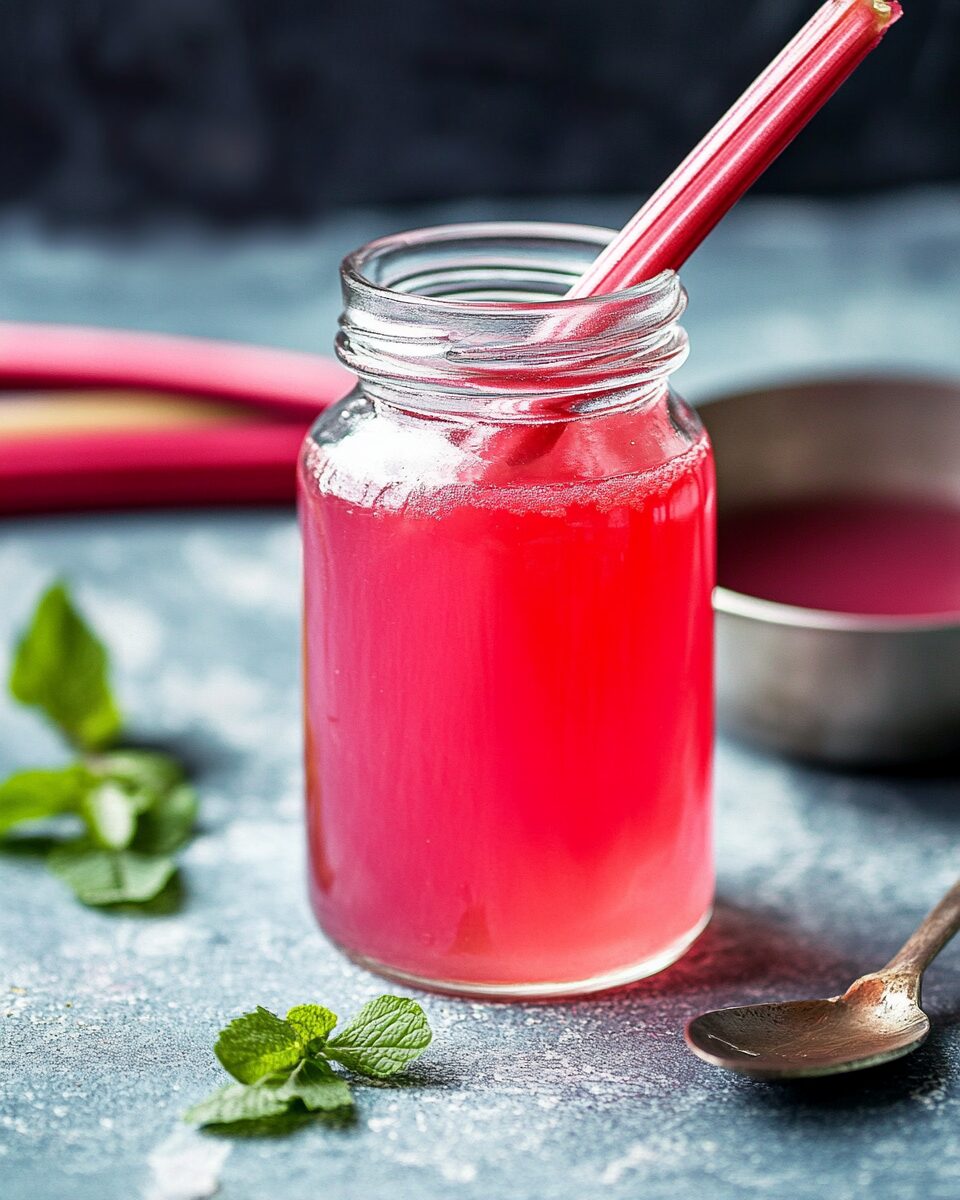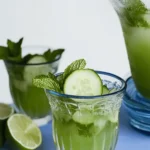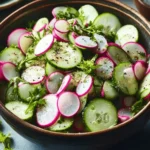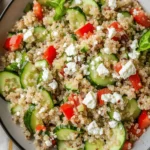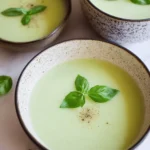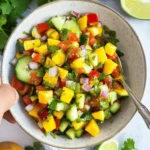A vibrant and tangy syrup made from fresh rhubarb, perfect for adding a splash of seasonal flavor to cocktails, lemonades, or desserts. This simple recipe creates a beautiful pink syrup that’s both tart and sweet, ideal for spring and summer drinks.
FULL RECIPE
Ingredients
- 2 cups chopped fresh rhubarb (about 3-4 stalks)
- 1 cup granulated sugar
- 1 cup water
Directions
- Combine chopped rhubarb, sugar, and water in a medium saucepan.
- Bring to a gentle boil over medium heat, then reduce heat and simmer for 20 minutes, stirring occasionally.
- Remove from heat and let the mixture cool for 10 minutes.
- Strain the syrup through a fine mesh sieve into a clean container, pressing on the solids to extract all the liquid.
- Discard the solids and let the syrup cool completely.
- Store in an airtight container in the refrigerator for up to 2 weeks.
Nutritional Information
- Calories: 50
- Carbohydrates: 13g
- Sugar: 13g
- Fat: 0g
- Protein: 0g
- Fiber: 0g
- Sodium: 0mg
The History of Rhubarb Simple Syrup
Rhubarb has been used in cooking and medicine for centuries, originating in Asia before making its way to Europe and North America. Rhubarb simple syrup is a modern twist on traditional rhubarb uses, turning the tart stalks into a versatile sweetener that enhances many beverages and dishes. Historically, simple syrups have been a staple in bartending and cooking because they dissolve easily in cold liquids, making rhubarb syrup a flavorful and convenient addition.
Flavor Profile
Rhubarb simple syrup offers a unique balance of tartness and sweetness. The natural tang of rhubarb pairs beautifully with sugar, creating a syrup that is bright and refreshing. Its vibrant pink color adds visual appeal to drinks and desserts. The flavor is both fruity and slightly tangy, making it ideal for enhancing flavors without overpowering them.
Uses in Cocktails
One of the most popular uses of rhubarb simple syrup is in cocktails. It works wonderfully as a sweetener in classic and modern mixed drinks alike. The tartness of the rhubarb adds complexity to cocktails such as gin and tonics, mojitos, and whiskey sours. Bartenders appreciate it for the color and fresh flavor it imparts, giving a unique twist to familiar drinks.
In Non-Alcoholic Beverages
Beyond alcoholic drinks, rhubarb simple syrup is excellent in non-alcoholic beverages. It can be added to sparkling water or lemonade to elevate the flavor. It is also a great ingredient for making mocktails or flavored iced teas, providing a bright and fruity note that refreshes and delights.
Enhancing Desserts
Rhubarb simple syrup is a great way to add moisture and flavor to desserts. Drizzling it over cakes, ice cream, or fresh fruit can elevate the taste experience. It can also be used as a glaze or mixed into frostings and fillings, offering a fresh, tangy contrast to rich, sweet desserts.
Homemade vs. Store-Bought
Making rhubarb simple syrup at home ensures freshness and control over sweetness. Store-bought syrups often contain preservatives or artificial flavors, while homemade syrup is pure and customizable. Adjusting sugar levels or experimenting with additional flavors like ginger or vanilla is easier when making it yourself.
Seasonality and Freshness
Rhubarb is typically in season during the spring and early summer, making this syrup a great way to capture the fresh taste of the season. Using fresh rhubarb yields the best flavor and color. However, frozen rhubarb can be used when fresh stalks are unavailable, though it may affect the syrup’s texture and intensity.
Storage and Shelf Life
Proper storage is essential for maintaining the quality of rhubarb simple syrup. When kept in an airtight container in the refrigerator, the syrup typically lasts up to two weeks. It can also be frozen for longer storage, although freezing may slightly alter its texture. Labeling with the date ensures you use it while it’s fresh.
Health Benefits
Rhubarb contains vitamins like vitamin K and C, along with antioxidants and fiber. While the syrup does contain sugar, using rhubarb adds some nutritional value not found in plain simple syrup. It is important to consume it in moderation, especially for those monitoring sugar intake.
Variations in Sweetness
The amount of sugar in rhubarb simple syrup can be adjusted depending on personal taste or intended use. Some prefer a more tart syrup with less sugar, while others like it sweeter for easier mixing. Experimenting with sugar levels allows for versatility in different recipes.
Pairing with Herbs and Spices
Adding herbs like mint, basil, or thyme during the cooking process can enhance the flavor profile of the syrup. Spices such as ginger, cinnamon, or vanilla add warmth and complexity. These additions create unique variations suitable for specific drinks or dishes.
Using Rhubarb Syrup in Cooking
Beyond drinks and desserts, rhubarb syrup can be used in savory cooking. It pairs well with grilled meats, especially pork and chicken, as a glaze or marinade ingredient. The tartness cuts through rich flavors and adds a pleasant contrast.
Nutritional Considerations
While delicious, rhubarb syrup is still a sugar-based product, so it should be used thoughtfully, especially for those with dietary restrictions. Using natural sweeteners or reducing sugar in the recipe can make it a bit healthier. Understanding its nutritional impact helps balance enjoyment and health.
Environmental Impact
Making homemade syrup reduces waste by using fresh, seasonal ingredients and minimizing packaging compared to store-bought syrups. Growing rhubarb is relatively low-impact, requiring minimal pesticides and water, making rhubarb syrup a sustainable option for flavoring.
Cultural Significance
Rhubarb has a strong cultural presence in many regions, especially in Northern Europe and North America. Its use in syrups and preserves reflects a tradition of preserving seasonal produce for year-round enjoyment. Rhubarb syrup ties modern culinary trends to these historical practices.
Tips for Perfect Syrup
Key tips for making the best rhubarb simple syrup include using fresh rhubarb, simmering gently to extract flavors without bitterness, and straining well to ensure smooth syrup. Cooling completely before storing prevents spoilage and preserves taste and color.
Pairing with Food
Rhubarb syrup pairs well with cheeses, especially creamy or tangy varieties like goat cheese or ricotta. It also complements nuts and baked goods, enhancing flavor with its sweet and sour notes. Experimenting with pairings can inspire new culinary creations.
Using Rhubarb Syrup in Coffee and Tea
Adding rhubarb syrup to hot or iced coffee and tea gives a fruity twist to traditional beverages. It sweetens naturally while introducing a pleasant tang that balances the bitterness of coffee or tannins in tea, making it a delightful alternative sweetener.
Creative Serving Ideas
Rhubarb syrup can be turned into frozen treats by mixing with water or juice and freezing into popsicles. It also works well as a drizzle on pancakes, waffles, or yogurt for breakfast or brunch, adding a burst of spring flavor.
Allergy and Dietary Notes
Rhubarb syrup is naturally gluten-free and vegan, making it suitable for many diets. However, those sensitive to oxalates, present in rhubarb, should consume it cautiously. Knowing the dietary aspects ensures safe enjoyment by diverse audiences.
Conclusion
Rhubarb simple syrup is a versatile and flavorful ingredient that brings a fresh, tangy twist to drinks and dishes alike. Its bright color and unique taste make it a favorite for both home cooks and professional bartenders. By experimenting with sweetness levels, adding herbs or spices, and using it across a range of culinary applications, rhubarb syrup can elevate your recipes in countless ways. Whether enhancing cocktails, brightening desserts, or adding depth to savory dishes, this homemade syrup captures the essence of seasonal rhubarb in a convenient and delicious form. Embracing rhubarb syrup not only offers a taste of tradition but also invites creativity and freshness into everyday cooking and entertaining.

